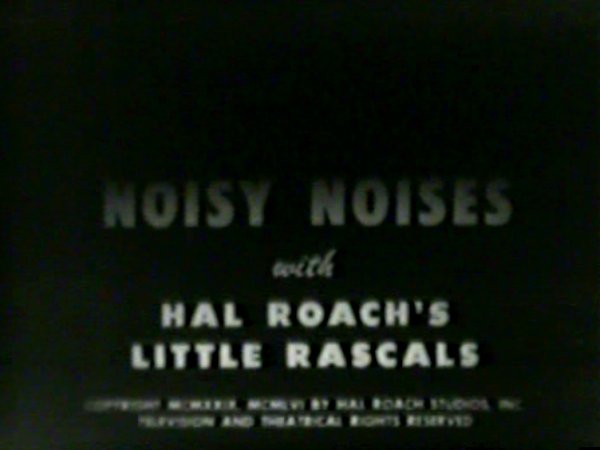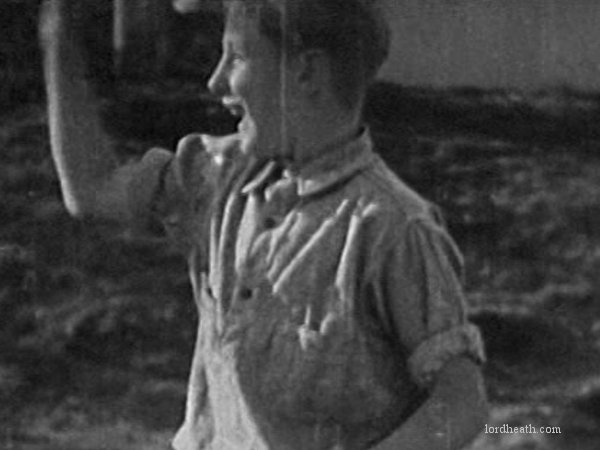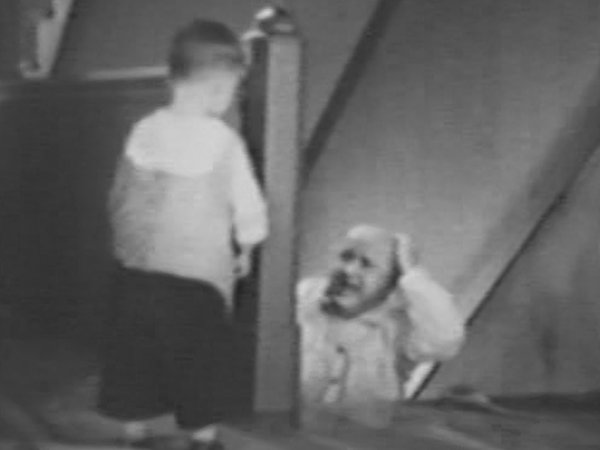
Noisy Noises
 |
| Plot summary and review by Robert Winslow: We open on Joe, who has a number of problems. The first: "For three hours on Saturday little Rupert had cried like a police siren---" The second: Joe has a "jumping toothache" exacerbated by Rupert's nonstop crying. Third, "world's champion bug clunker" Wheezer, Joe's other brother, is using a claw hammer to exterminate insects in the adjacent kitchen, assisted by Pete the Pup. (A setup reworked with Spanky in the 1932 short Spanky). Joe manages to get Rupert quiet, only to have Wheezer startle the infant with hammer pounding and upsetting pots and pans. Several times Joe goes into the kitchen to confront Wheezer, only to find an empty room – Wheezer and Petie have hidden inside an air duct. Joe finally tricks Wheezer by slamming the back door; thinking Joe's left, Wheezer comes out of abeyance, and Joe promptly shuts him out of the kitchen onto the back landing. Here Wheezer continues his bug hunting, clunking a neighbor (Fred Holmes) on the head in the process. Joe apparently resides in an apartment building tenanted by fiends, because no sooner has he gotten Rupert to lie down when one neighbor starts in practicing the bass fiddle. The grating sounds have seemingly awoken demonic presences causing pictures on the wall to revolve a la The Exorcist, drapes to fly up, and furniture to vibrate. Joe tries rocking Rupert in his cradle, only to have the cradle disintegrate and spill both of them onto the floor. Not to be outdone, other members of the Gang have formed a marching band and are practicing outside on discordant and improvised instruments (washtubs, pots, lids). Joe summons the Gang to help him (Farina's expression when confronted by Rupert is priceless). The Gang attempts entertaining Rupert with their "music" and some horns and noisemakers, plus a bottle of milk, which ends up underneath Joe and soaking his pants. (Rupert's temporarily amused when Joe discards the milk bottle inadvertently onto Farina's head). Success at last – Rupert's asleep. |
|
Asleep, that is, until one of the building's other denizens from Hell, playing a tuba, starts in. Farina hits on the idea of having the Gang confront the tuba player while sucking on lemons (a gag also seen in 1934's Mike Fright). The tuba player succumbs to a pucker, but now another fiend in the shape of a soprano taking music lessons begins vocalizing. (Seriously, this building seems to be the repository of every untalented musical amateur in the county). Even Petie can't stand this noise. "Sounds like murder!" comments Farina, who then discovers a rat in a nearby trash can and sets it at the soprano's feet. This causes the woman to really hit some high notes, and she soon takes a head-first dive out the window – somewhat to the relief of her teacher (Michael Mark).
Joe's mother (Lyle Tayo) returns home, and the film moves on to its next gag situation – liberating Joe from his troublesome tooth. Mama has given Joe a whole dollar to pay the cost of an extraction, and the Gang head off to the dentist. A reworking of Laurel and Hardy's Leave ‘Em Laughing is averted, however, when another kid warns them away from the dentist. Farina is more than pleased to have the Gang pull Joe's tooth instead, saving the dollar for them all to spend. Farina ties one end of a string to Joe's tooth and the other end to Pete the Pup's collar, but when Petie runs after a ball Farina throws, Joe runs after him rather than let the tension on the string pull out his tooth. Result – failure. "If yo'd a stood still, Round Boy, she'd a bin out!" Farina tells Joe. The tooth finally does come out when Pete takes off after a cat. But Joe doesn't notice, because he now has more important things to deal with – Wheezer, still bug hunting on the sidewalk, sets in motion Rupert's pram, which careens down a hill. Gathering speed, the pram picks up a monkey (which looks to be Josephine, Tony Campanaro's star, who recently had appeared in Buster Keaton's The Cameraman). The pram only narrowly misses a motorcycle policeman, then a number of automobiles. Meanwhile Rupert, who's spent the whole day crying, is now absolutely overjoyed by the monkey, the excitement, and the noisemaker he finds onboard the pram. The Gang gives chase to the pram, with the monkey leaping off onto Joe's back, causing him to lose his pants and hampering his efforts to halt the pram. While hoisting his pants and resuming the chase, the dollar bill falls out of Joe's shirt pocket. Wheezer (who's somehow managed to keep pace with everyone despite being only a three-year-old toddler) finds the dollar in the street, but is talked into selling it to a kid in exchange for a bright new cent. The Gang catches up to Rupert and the pram, Joe finds his tooth is gone, and all seems to be ending happily until Joe finds his dollar gone. He spots the kid who's bought the dollar off Wheezer, and the Gang takes off after him, with Joe losing his pants entirely in the process, as we iris out. |
| Trivia • Copyrighted March 5, 1929. • The 82nd film in the series to be released. • Film Daily listed the release date of February 1, 1929. • Joe's dollar is a Silver Certificate of the 1923 issue, though of which series is impossible to determine. • Joe's apartment contains a framed painting seen in many other Hal Roach comedies of this time period, such as Unaccustomed As We Are. The painting seems to depict a line of trees in distant perspective. • There's a wall telephone and phone book just outside the back door to Joe's apartment. • In the shot showing the monkey and its sleeping owner (who may well be Tony Campanaro though his face isn't shown; there's a hurdy-gurdy music box propped against the bench he's sleeping on), two billboards can be seen in the background. One (the left) advertises razors; the other (to the right) has an ad for a contemporary movie. • Joe has rigged up a number of toys, rattles, and pictures above Rupert's cradle, attached to lines he can manipulate while lying on the sofa nursing his tooth, somewhat similar to the setup of Snub Pollard's apartment in 1923's It's a Gift. Possibly they were the object of gags that didn't make it into the finished film. When we first see Farina and the other Gang members' marching band, they appear to be walking beside the rail tracks in between the Hal Roach Studio property and National Boulevard. Some large piles of lumber are in the background, behind a picket fence. Later, a truck dropping off (literally) a load of lumber that awakens Rupert is seen near the studio gate adjacent to Hubbard St. The garages housing the Hal Roach Studio motor pool are visible in the background, as is the mill shed where Laurel and Hardy "work" in Busy Bodies. • The Model T Ford that does a nose stand does so in approximately the same spot on the Back Lot as Laurel and Hardy and Edgar Kennedy sank in a Model T in Leave 'Em Laughing, and where Oliver Hardy encounters a deep puddle in Angora Love. We also see the manhole occupied by Dick Gilbert in The Battle of the Century and seen as well in You're Darn Tootin' and A Chump at Oxford (in the latter, Stan golfs an apple into the open hole, scoring a hole-in-one on Al Thompson's head). • Joe calls the tuba a "grunt horn," which was contemporary slang for the instrument among jazz musicians. Robert Winslow's opinion • One of the better Our Gangs from this period, which tend to be a mixed lot. It has two distinct gag sequences that are developed and exploited, rather than attempting random gags interspersed with sentiment. At the time of filming the Roach studio was beginning the transition to producing sound films by rebuilding the existing shooting stages to adapt to the requirements of sound recording. This work began around August of 1928 and continued through early 1929, with installation of the recording equipment during mid-March 1929, about a month after when Noisy Noises reached theaters. Because so many of its gags rely on reactions to specific sounds, the film really needs to be viewed with its complementing sound-on-disc track, which emphasizes the "noise" gags. In fact, the film might have been better served had Robert McGowan and Roach waited until the arrival of sound equipment, for the film is much better paced and gag-filled than the first half-dozen or so Our Gangs filmed with full sound. Sound would have allowed reaction shots, particularly those made by Farina in response to crying, off-key musical instruments, and so on, to emphasize specific gags. Still, audiences of the time must have been impressed by the plethora of sound effects that accompany the Vitaphone music track, but it's the reactions of the Gang (especially Farina) to the sounds that elevate this comedy to something more than a gimmicked-up hybrid. The runaway pram finale derives a lot of its force from being staged wholly outdoors on location, affording plenty of glimpses of 1928 Culver City. Had the story for Noisy Noises been held back six months until the studio was equipped for sound films, these sequences might have been restricted by having to transport the recording equipment on location, and might have curtailed some of the film's best scenes. |
| Joe Cobb Joe |
Warren Mills Rupert |
Bobby Hutchins Wheezer |
Allen Hoskins Farina |
Harry Spear Harry |
George Dunning George |
Andy Shuford Andy |
Gordon Thorpe Gordon |
Mary Ann Jackson Mary Ann |
Jean Darling Jean |
Jay R. Smith Jay |
 |
Buddy Moore Boy who gives Wheezer a penny for the dollar bill |
 |
Fred Holmes Bald man on stairs |
Michael Mark Voice coach |
Jack O'Brien Lemon vendor |
Lyle Tayo Joe's mother |
Edith Fortier Pedestrian |
Joe Bonner Tuba player |
| Acknowledgements: The Little Rascals: The Life And Times Of Our Gang by Leonard Maltin & Richard W. Bann (book) http://www.theluckycorner.com/rms/082.html (Robert Demoss/The Lucky Corner) Robert Winslow (plot summary and review notes) This page was last updated on: 31 October 2025 |